
The Iraqi dinar is the currency of Iraq. It is issued by the Central Bank of Iraq and is subdivided into 1,000 fils (فلس), although inflation has rendered the fils obsolete since 1990. On 7 February 2023, the exchange rate with the US Dollar was US$1 = 1300 dinars.
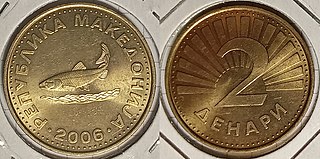
The denar is the currency of North Macedonia. Though subdivided into one hundred deni (дени), coins with a denomination of less than one denar have not been in use since 2013.
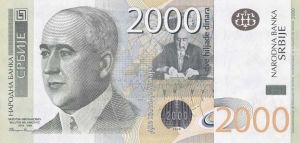
The dinar is the currency of Serbia. The dinar was first used in Serbia in medieval times, its earliest use dating back to 1214. The dinar was reintroduced as the official Serbian currency by Prince Mihailo Obrenović in the 1868. One dinar was formerly subdivided into 100 para.

The kuna was the currency of Croatia from 1994 until 2023. It was replaced by the euro in 2023. The kuna was subdivided into 100 lipa. It was issued by the Croatian National Bank and the coins were minted by the Croatian Mint.

The krone was the official currency of Austria-Hungary from 1892 until the dissolution of the empire in 1918. The subunit was one hundredth of the main unit, and was called a Heller in the Austrian and a fillér in the Hungarian part of the Empire.

The rial is the official currency of the Republic of Yemen. It is technically divided into 100 fils, although coins denominated in fils have not been issued since Yemeni unification. Due to the ongoing political instability, the value of the Yemeni rial has fallen significantly.
Each "article" in this category is a collection of entries about several stamp issuers, presented in alphabetical order. The entries are formulated on the micro model and so provide summary information about all known issuers.
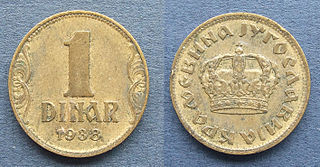
The dinar was the currency of Yugoslavia. It was introduced in 1920 in the Kingdom of Serbs, Croats and Slovenes, which was replaced by the Kingdom of Yugoslavia, and then the Socialist Federal Republic of Yugoslavia. The dinar was subdivided into 100 para.
The dinar was the currency of Croatia between 1991 and 1994. The ISO 4217 code was HRD.

The Krajina dinar was the currency of the Republic of Serbian Krajina between 1992 and 1994.
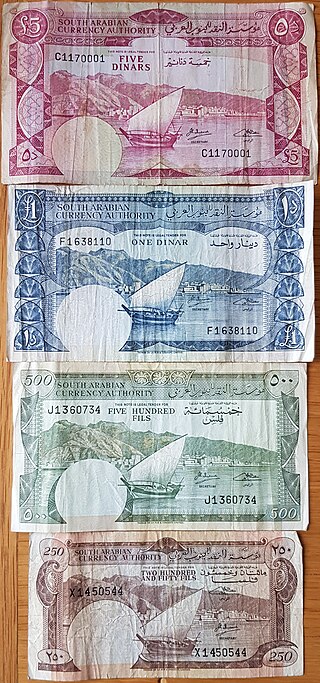
The dinar was the currency of South Arabia and then South Yemen between 1965 and 1990. It was subdivided into 1000 fils (فلس). After Yemen's monetary unification on 1 July 1990, it was one of the two official currencies used in Yemen Republic until 11 June 1996.
The Bosnia and Herzegovina dinar was the independent currency of Republic of Bosnia and Herzegovina between 1992 and 1998.
The Republika Srpska dinar was the currency of Republika Srpska between 1992 and 1994 during the Bosnian War. There were two distinct currencies issued by the National Bank of the Republika Srpska. The first was introduced in 1992 in conjunction with the Yugoslav dinar of that year, to which it was equal. The second was introduced on 1 October 1993, replacing the first at a rate of one million to one and matching the revaluation of the Yugoslav currency. Following this, the Republika Srpska used the Yugoslav dinar until 1998, when the Bosnia and Herzegovina convertible mark was introduced.

The Republic of Bosnia and Herzegovina was a state in Southeastern Europe, existing from 1992 to 1995. It is the direct legal predecessor to the modern-day state of Bosnia and Herzegovina.
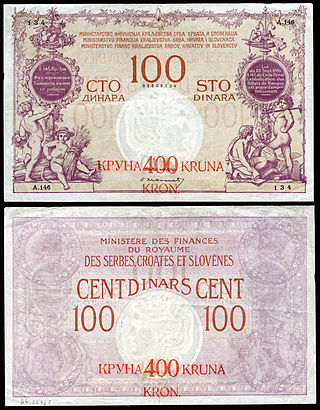
The krone was a short-lived, provisional currency used in parts of the then newly formed Kingdom of Serbs, Croats, and Slovenes, parts of which had previously been part of the Austro-Hungarian Empire (Austria-Hungary). It was worth 1⁄4 of a dinar or 25 para and subdivided into one hundred hellers. The name translates into English as crown.
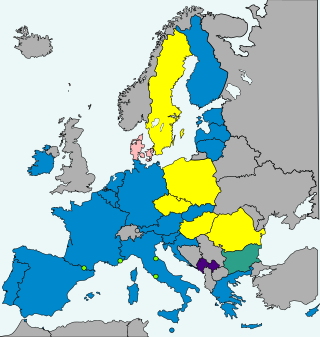
Montenegro is a country in South-Eastern Europe, which is neither a member of the European Union (EU) nor the Eurozone; it does not have a formal monetary agreement with the EU either. However, it is one of the two territories that has unilaterally adopted the euro in 2002 as its de facto domestic currency. This means that even though the euro is not a legal tender there, it is treated as such by the government and the population.

Kosovo adopted the euro as its de facto legal tender in 2002 despite the territory not being a member of the Eurozone or the European Union. This succeeded its use of German marks from 1999.

The kuna was the currency of the Independent State of Croatia from 1941 until 1945. The word kuna means "marten" in Croatian and the same name is used for the modern Croatian kuna currency, which was later replaced with the euro. This kuna was subdivided into 100 banica. It was preceded and replaced by the Yugoslav dinar.
The banknotes of the Yugoslav dinar were several series of paper money printed by the central bank of the different consecutive states named Yugoslavia.
This is a description of the current and historical currencies of Croatia, or historically used in the region. The currency of Croatia is the euro, in use since 2023.















